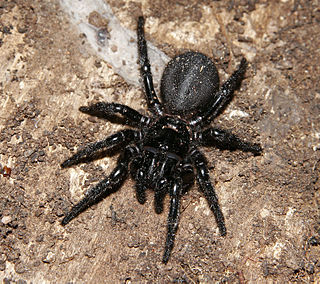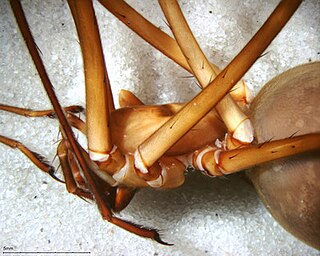
Atracidae is a family of mygalomorph spiders, commonly known as Australian funnel-web spiders or atracids. It has been included as a subfamily of the Hexathelidae, but is now recognized as a separate family. All members of the family are native to Australia. Atracidae consists of three genera: Atrax, Hadronyche, and Illawarra, comprising 35 species. Some members of the family produce venom that is dangerous to humans, and bites by spiders of six of the species have caused severe injuries to victims. The bite of the Sydney funnel-web spider and northern tree-dwelling funnel-web spider are potentially deadly, but no fatalities have occurred since the introduction of modern first-aid techniques and antivenom.

Crevice weaver spiders (Filistatidae) comprise cribellate spiders with features that have been regarded as "primitive" for araneomorph spiders. They are weavers of funnel or tube webs. The family contains 18 genera and more than 120 described species worldwide.

Hexathelidae is a family of mygalomorph spiders. It is one of a number of families and genera of spiders known as funnel-web spiders. In 2018, the family was substantially reduced in size by genera being moved to three separate families: Atracidae, Macrothelidae and Porrhothelidae. Atracidae includes the most venomous species formerly placed in Hexathelidae.
Kaiya is a genus of Australian large-clawed spiders that was first described by Raymond Robert Forster, Norman I. Platnick & Michael R. Gray in 1987.

Atrax is a genus of venomous Australian funnel web spiders that was first described by O. Pickard-Cambridge in 1877 from the type species Atrax robustus. As of May 2019 it contains only three species: A. robustus, A. sutherlandi, and A. yorkmainorum. Originally placed with the curtain web spiders, it was moved to the Hexathelidae in 1980, then to the Australian funnel-web spiders in 2018.

Hadronyche is a genus of venomous Australian funnel-web spiders that was first described by L. Koch in 1873. Originally placed with the curtain web spiders, it was moved to the Hexathelidae in 1980, then to the Australian funnel-web spiders in 2018.

Barychelidae, also known as brushed trapdoor spiders, is a spider family with about 300 species in 42 genera. Most spiders in this family build trapdoor burrows. For example, the 20 millimetres (0.79 in) long Sipalolasma builds its burrow in rotted wood, with a hinged trapdoor at each end. The 10 millimetres (0.39 in) long Idioctis builds its burrow approximately 5 centimetres (2.0 in) deep, just below the high tide level, sealing the opening with a thin trapdoor.

Orsolobidae is a six-eyed spider family with about 180 described species in thirty genera. It was first described by J. A. L. Cooke in 1965, and was raised to family status from "Dysderidae" in 1985.

Stiphidiidae, also called sheetweb spiders, is a family of araneomorph spiders first described in 1917, Most species are medium size and speckled brown with long legs. All members of this family occur in New Zealand and Australia except for Asmea. They build a horizontal sheet-like web under rocks, hence the name "sheetweb spiders".

Macrogradungula is a monotypic genus of Australian large-clawed spiders containing the single species, Macrogradungula moonya. It was first described by Raymond Robert Forster, Norman I. Platnick & Michael R. Gray in 1987, and has only been found in Australia. It is classified under the family Gradungulidae, superfamily Austrochiloidea, and suborder Araneomorphae.
Bengalla is a monotypic genus of Australian wandering spiders containing the single species, Bengalla bertmaini. It was first described by Michael R. Gray & J. A. Thompson in 2001, and has only been found in Australia. It was originally assigned to the superfamily "Lycosoidea", but not to any actual family. In 2003, it was tentatively moved to the Ctenidae because of its apparent relationship to Janusia, another Australian monotypic genus of wandering spiders.
Janusia is a monotypic genus of Australian wandering spiders containing the single species, Janusia muiri. It was first described by Michael R. Gray in 1973, and has only been found in Australia. Originally placed with the Miturgidae, it was moved to the Ctenidae in 1989.
Colcarteria is a genus of Australian intertidal spiders that was first described by Michael R. Gray in 1992. As of May 2019 it contains only three species: C. carrai, C. kempseyi, and C. yessabah.
Wandella is a genus of Australian crevice weavers that was first described by Michael R. Gray in 1994.
Tarlina is a genus of Australian large-clawed spiders that was first described by Raymond Robert Forster, Norman I. Platnick & Michael R. Gray in 1987.
Asmea is a genus of Papuan sheetweb spiders that was first described by M. R. Gray & H. M. Smith in 2008.
Borrala is a genus of New South Welsh sheetweb spiders that was first described by M. R. Gray & H. M. Smith in 2004.
Karriella is a genus of Western Australian sheetweb spiders that was first described by M. R. Gray & H. M. Smith in 2008. As of September 2019 it contains two species, found in Western Australia: K. treenensis and K. walpolensis.
Pillara is a genus of New South Welsh sheetweb spiders that was first described by M. R. Gray & H. M. Smith in 2004.
Therlinya is a genus of Australian sheetweb spiders that was first described by M. R. Gray & H. M. Smith in 2002.








